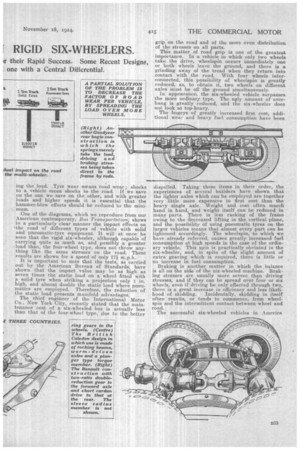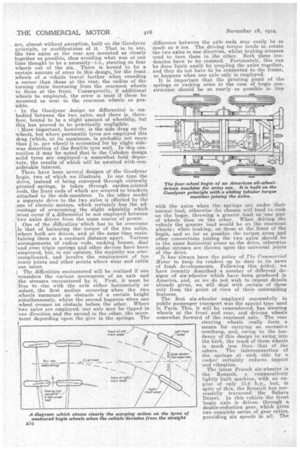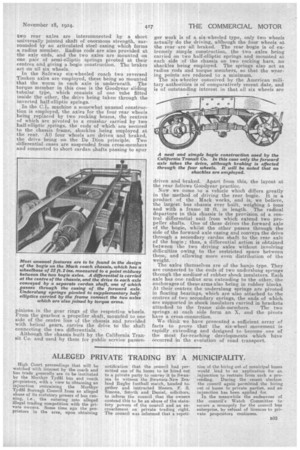THE GROWING INTEREE r RIGID SIX-WHEELERS.
Page 16

Page 17

Page 18

Page 19

If you've noticed an error in this article please click here to report it so we can fix it.
THE ADVENT of a British builder of motor vehicles into the rapidly filling ranks of makers of six-wheeled rigid-framed vehicles is a matter the importance of which cannot be over-emphasized. The Commercial Motor has for ninny years strongly urged the claims of this type of multi-wheeled vehicle for the transport both of goods and .passengers, and we hope that this first effort—in a direction in which, we am firmly convinced, lies a great field—will encourage others to follow suit.
Realizing, as we do, the manifold advantages of spreading the load over a greater number of wheels than the usual four, it has been a subject of disappointment to us that steps had not been taken a long time ago thoroughly to try out its merits and the various designs which can be employed in sixwheeler construction.
We do not wish our readers to confuse the rigid six-wheeler with the tractor-trailer type of vehicle. The latter is quite a different machine ; it is a hybrid type, and, although it has fulfilled certain useful functions, the chief reason for its development has been the wish to carry far greater loads on the one vehicle.
It is our view that a rigid-framed six-wheeler sheuld not be designed so much for the carrying of bigger loads as for the more even distribution of those existing.
There is no doubt that the six-wheeler has already proved its worth. In America there are some half a dozen makers whose products in this connection have proved eminently satisfactory—so much so, indeed, that a large number 9f six-wheeled, and even eight-wheeled, single-deck buses are in active service, many running 8,000 miles or more per month, and news is now to hand that the Moreland Motor Truck Co. have recently supplied the first batch of a large fleet of double-deck six-wheeled buses, built on the Goodyear principle, to the Los Angeles Railway Co. It is of interest to analyse the reasons for the growing success of this new type of vehicle. The most important is apparently the wish on the nart of those running passenger vehicles to provide a larger measure of comfort for their passengers, and
at the same time to carry, what we may perhaps be forgiven for calling, a paying load. Comfort is assisted by the provision of pneumatic-tyre equipment, but large single tyres have not proved entirely satisfactory for the largest passenger vehicles ; consequently, it has proved necessary to spread the load over more tyres. This can be done either by fitting dual tyres on the rear wheels or by increasing the number of wheels. The experience in the States has gone to show that the twin tyre presents certain disadvantages, such as uneven loading, due to the camber of the road, and the additional leverage exerted on the overhanging axle ends. . It has also been shown that the shocks transmittedthrough a twin-tyred wheel are greater than those experienced with the multi-wheeled vehicle in which the two axles at the rear are mounted to form a non-swivelling bogie.
In such a design, when the wheels of one axle pass over a projection in the road, the raising of the spring weight is only half that occurring in the ordinary vehicle, but the time allowance is the same ; consequently, as the impact force equals .1.10/2, the reactions and stresses are actually only one-quarter of those experienced with a vehicle having only one rear axle.
Thus, the multi-wheel design is vastly superior, even if we do not consider the question of spread ing the load. Tyre wear means road wear ; shocks to a vehicle mean shocks to the road. If we save on the one we save on the other, and with greater loads and higher speeds it is essential that the hammer-blow effects should be reduced to the minimum.
One of the diagrams, which we reproduce from our American contemporary, Bus Transportation shows in a particularly clear manner the impact effects on -the road of different types of vehicle with solid and pneumatic-tyre equipment. It will at once be seen that the rigid six-wheeler, although capable of carrying quite as much as, and possibly a greater .• load than, the four-wheel type, doe-s not throw anything like the same stresses on the road. These results are shown for a speed of only 17i m.p.h. It is important to note that the tests, as carried out by the American Bureau of Standards, have shown that the impact value may be as high as seven times the static load on a wheel fitted with a solid tyre when striking a projection only 1 in. high, and almost double the static load where pneumatics are employed. Therefore, the reduction of the static load presents manifold advantages. • The chief engineer of the International Motor Co., New York City, recently stated that the maintenance cost of a six-wheeled bus is actually less than that of the four-wheel type, due to the better grip onthe road and of the more even distribution of the stresses on all parts. This matter of road grip is one of the greatest importance. In a vehicle in which only two wheels take the drive, wheelspin occurs immediately one or both wheels leave the ground, and there is a grinding away of the tread when they return into contact with the road. With four wheels interconnected, this possibility of wheelspin is greatly reduced, as, to obtain it, two wheels on different axles must be off the ground simultaneously.
In appearance, the six-wheeled vehicle surpasses the more ordinary type. The ugly amount of overhang is greatly reduced, and the six-wheeler does not look so top-heavy. The bogeys of greatly increased first cost, additional wear and heavy fuel consumption have been dispelled. Taking these items in their order, the experiences of several builders have shown that the lighter axles which can be employed are together very little more expensive in first cost than the heavy single axle. Weight and cost often march hand in hand, and weight itself can be reduced in many parts. There is less racking of the frame owing to the decreased lifting in the vertical plane, and the possibility of using pneumatic tyres on the larger vehicles means that almost every part can be lightened accordingly. The wheelspin, to which we have already referred, causes greatly increased fuel consumption at high speeds in the case of the ordinary vehicle: This spin is practically obviated in the six-wheeler, and, in spite of the slight amount of extra gearing which is required, there is little or no increase in fuel consumption. Braking is another matter in which the .balance is all on the side of the six-wheeled machine. Braking stresses are usually more severe than driving Stresses, and if they can be spread over four or six wheels, even if driving be only effected through two, there is a great increase in efficiency and less likeli
hood of skidding. Incidentally, skidding in itself often results, i or tends to commence, from wheelspin and the intermittent contact between wheel and road.
The successful six-wheeled vehicles in America are, almost without exception, built on the Goodyear principle, or modifications of it. That is to say, the two axles at the rear are mounted as closely together as possible, thus avoiding what was at one time thought to be a necessity—i.e., steering on four wheels out of the six. There is bound to be a certain amount of error in this design, for the front , wheels of a vehicle travel farther when rounding a corner than those at the rear, the radius of the turning circle increasing from the rearmost wheels to those at the front. Consequently, if additional wheels be employed, the error is least if these be mounted as near to the rearmost wheels as possible.
In the Goodyear design no differential is embodied between the two axles, and there is, therefore, bound to be a slight amount of wheelslip, but this has proved to be practically negligible. More important, however, is the side drag on the wheels, but where pneumatic tyres are employed this drag (which, at its maximum, is probably not more than g in. per wheel) is accounted for by slight sideway distortion of the flexible tyre wall. In this con. nection it may be noted that in the Caledon design solid tyres are employed—a somewhat bold departure, the results of which will be awaited with-considerable interest.
' There have been several designs of the Goodyear bogie, two of which we illustrate. In one type the drive, instead of being conveyed through centrally pivoted springs, is taken through cardari-jointed rods, the front ends of which are secured to brackets attached to the side-members. In the other model a separate drive to the two axles is effected by the use of electric motors, which certainly has the ad[vantage of overcoming the slight wheelslip which ,must occur if a differential be not employed between two axles driven from the same source of power.
One of the difficulties'which has to be overcome is that of balancing the torque of the two axles, where both are driven, and at the same time maintaining them at a constant distance apart. Various arrangements of radius rods, rocking beams, dual and even triple springs and other devices have been employed, but, in our opinion, the majority are overcomplicated, and involve the employment of too many joints and other points where wear and rattle can occur.
The difficulties encountered will be realized if one considers the -various movements of an axle and the stress'es encountered by it. First, it must be l'free to rise with the axle either horizontally or aslant, the first motion occurring when the two ,wheels surmount an obstacle of a certain height simultaneously, whilst the second happens when one wheel crosses an obstacle before the other. Where ,two axles are employed, one axle may be tipped in !one direction and the second in the other, the movement depending upon the give in the springs. The difference between the axle ends may easily be so much as 9 ins. The driving torque tends to rotate the two axles in one direction, whilst braking stresses tend to turn them in the other. Both these tendencies have to be resisted. Fortunately, this can be done fairly easily by coupling the axles together, and they do not have to be connected to the frame, as happens when one axle only is employed. It is important that the pivoting point of the springs or rocking arms in the case of bogie construction should be as nearly as possible in line
with the axles when thesprings are, under their normal load, otherwise the chassis will tend to rock on the bogie, throwing a greater load on-one pair of wheels than on the other. When driving the -vehicle the greater load would be OT1 .the rearmost wheels ; when braking, on those at thefront of the bogie, and so far as possible the torque arms and other connections joining the two axles should be in the same horizontal plane as the drive, otherwise undue stresses are thrown upon the universal joints of the drive.
It has-always been the policy of The dommercial Motor to keep its readers up to date in its news of fresh developments. Following this policy, we have recently described a number of different designs of six-wheeler which have • been produced in America, and, as we do not wish to repeat details already given, we will deal with certain of these only from the point of view of their outstanding features.
The first six-wheeler employed successfully in public passenger transport was the special type used in Paris. This, it will be remembered, has steering wheels at the front and rear, and drivine wheels somewhat forward of the rearmost axle. The rear steering wheels really form a means for carrying an excessive overhang, and, owing to the tendency of this design to swing into the kerb, the track of these wheels is much less than that of the others. The interconnection of the springs at each side by a rocker certainly reduces impact and vibration.
Left front -•"..wheel
";t: Center bemeeh frenswheel hoot;
—: • • /
The latest French six-wheeler is the Renault, a comparatively lightly built machine, with an engine of only 13.9 h.p., but, in spite of this, the Renault has successfully traversed the Sahara Desert, in this vehicle the front bogie axle is driven through a double-reduction gear, which gives two complete series of gear ratios, providing six speeds in all. The
two rear axles are interconnected by a short universally jointed shaft of enormous strength, surrounded by an articulated steel casing which forms a radius member. Radius rods are also provided at the axle ends, and the two axles are mounted on one pair of semi-elliptic springs pivoted at their centres and giving a bogie construction. The brakes act on all six wheels.
In the Safeway six-wheeled coach two reversed Timken axles are employed, these being so mounted that the worm in each axle is underneath. The torque member in this case is the Goodyear sliding tubular tyPe, which consists of one tube fitted inside the other, the drive being taken through the inverted half-elliptic springs.
In the C.I. machine a somewhat unusual construction is employed, the axles for the four rear wheels being replaced by two rocking beams, the centres of which are pivoted to a crossbar carried by two springs, the ends of which are secured to the chassis frame, shackles being employed at the rear. All four wheels are driven and braked, the drive being on the De Dion principle. Two differential eases are suspended from cross-members and connected to short carclan shafts passing to spur
pinions in the gear rings of the respective wheels. From the gearbox a propeller shaft, mounted to one side of the centre line of the chassis and provided -with helical gears, carries the drive to the shaft connecting the two differentials.
Although the chassis built by the California Transit Co. and used by them for public service passen
ger work is of a six-wheeled type, only two wheels actually do the driving, although the four wheels at the rear are all braked. • The rear bogie is of extremely simple construction, the two axles being carried on two half-elliptic springs and mounted at each side of the chassis on two rocking bars, no shackles being employed. The springs also act as radius rods and torque members, so that the wearing points are reduced to a minimum. The six-wheeler conceived by the American military authorities is of comparatively recent date, and is of outstanding interest in that all six wheels are driven and braked. Apart from this, the layout at the rear follows Goodyear practice.
Now we come to a vehicle which differs greatly in the method of driving the rear bogie. It is a product of the Mack works, and is we believe, the largest bus chassis ever built, weighing 5 tons and with a frame a ft. in length. The radical departure in this chassis is. the provision of a central differential unit from which extend two propeller shafts. One of these drives the forward axle of the bogie, whilst the other passes through the side of the forward axle casing and conveys the drive through a secondary cardan shaft to the rear axle of the bogie ; thus, a differential action is obtained between the two driving axles without involving difficulties owing. to the restricted space between them, and allowing more even distribution of the weight.
The axles themselves are of the banjo type. They are connected to the ends of two underslung springs through the medium' of rubber shock insulators. Each axle has one radius arm extending to the other, the anchorages of these arms also being in rubber blocks. At their centres the underslung springs are pivoted in floating bearings, which are also attached to the centres of two secondary springs, the ends of which are supported in shock insulators carried in brackets attached to the frame side-members. Thetwo springs at each side form an X, and the pivots have a cross-connection.
We think we have presented a sufficient array of facts to prove that the six-wheel movement is rapidly extending and designed to become one of the most far-reaching developments which have occurred in the evolution of road transport.
































